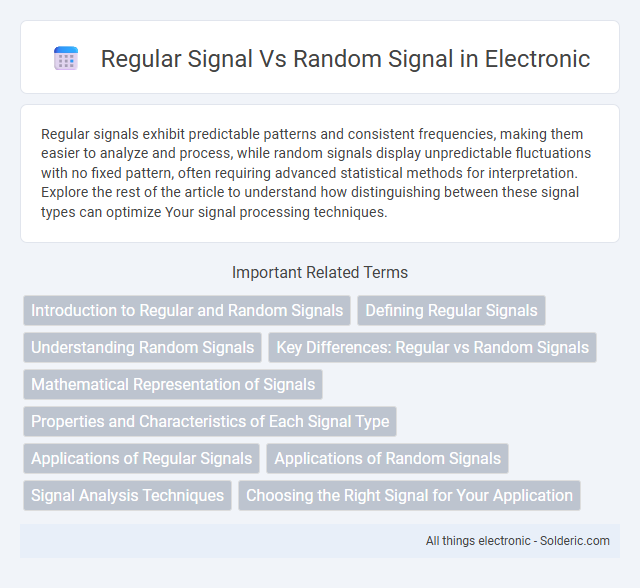Regular signals exhibit predictable patterns and consistent frequencies, making them easier to analyze and process, while random signals display unpredictable fluctuations with no fixed pattern, often requiring advanced statistical methods for interpretation. Explore the rest of the article to understand how distinguishing between these signal types can optimize Your signal processing techniques.
Comparison Table
| Feature | Regular Signal | Random Signal |
|---|---|---|
| Definition | Periodic or deterministic signal with fixed pattern | Non-deterministic, stochastic signal with unpredictable values |
| Predictability | High, future values can be predicted | Low, future values cannot be precisely predicted |
| Frequency Content | Discrete frequencies or harmonics | Continuous spectrum over frequency range |
| Examples | Sine wave, square wave, sawtooth | White noise, thermal noise, random telegraph signal |
| Use Cases | Signal processing, communications, control systems | Statistical signal analysis, noise modeling, random processes |
| Mathematical Representation | Deterministic functions (e.g., x(t) = A sin(ot)) | Random variables or stochastic processes |
| Amplitude Variation | Consistent, follows a known pattern | Varies unpredictably over time |
Introduction to Regular and Random Signals
Regular signals exhibit predictable, repeating patterns characterized by consistent frequency and amplitude, commonly found in communication systems and control processes. Random signals lack a deterministic structure, displaying unpredictable fluctuations influenced by noise or environmental factors, making them essential in modeling real-world phenomena like thermal noise or stock market variations. Understanding the contrast between your regular and random signals enables more effective signal processing and system design.
Defining Regular Signals
Regular signals exhibit predictable, repeating patterns characterized by consistent frequency, amplitude, and phase over time. These signals are often sinusoidal or periodic, allowing for straightforward analysis and efficient processing in communication systems. Understanding regular signals enables you to accurately model and interpret stable, deterministic data sources essential for control and signal processing applications.
Understanding Random Signals
Random signals exhibit unpredictable variations over time, characterized by statistical properties rather than deterministic patterns. Unlike regular signals with consistent and repeatable waveforms, random signals require analysis through probability distributions and correlation functions to understand their behavior. Understanding random signals allows you to model and process noise, interference, and other stochastic phenomena in communication and signal processing systems effectively.
Key Differences: Regular vs Random Signals
Regular signals exhibit predictable, periodic patterns with consistent frequency and amplitude, facilitating easier analysis and processing in communication systems. Random signals lack a deterministic pattern, displaying unpredictable variations that require statistical methods such as power spectral density and autocorrelation for characterization. Understanding these differences is crucial for designing filters, signal detectors, and noise reduction algorithms in signal processing applications.
Mathematical Representation of Signals
Regular signals are mathematically represented by deterministic functions, such as sine waves expressed as x(t) = A sin(2pft + ph), where amplitude (A), frequency (f), and phase (ph) are well-defined parameters. Random signals are modeled using stochastic processes characterized by probability density functions and statistical properties like mean, variance, and autocorrelation functions, often represented as X(t) with random variables at each time instant. The distinction in mathematical representation influences signal analysis techniques, with Fourier transforms applied to regular signals and statistical methods, such as power spectral density, used for random signals.
Properties and Characteristics of Each Signal Type
Regular signals exhibit predictable waveforms with consistent frequency, amplitude, and phase, making them ideal for deterministic system analysis and communication. Random signals demonstrate unpredictable variations in amplitude and phase over time, characterized statistically by parameters such as mean, variance, and autocorrelation functions. Their inherent stochastic nature necessitates probabilistic methods for signal processing and noise modeling in practical applications.
Applications of Regular Signals
Regular signals, characterized by predictable periodic patterns, are widely utilized in telecommunications for efficient data transmission and synchronization. In control systems, regular signals enable precise monitoring and regulation of machinery performance, ensuring stability and accuracy. Your ability to analyze these signals is crucial for designing systems in electronics, radar, and audio processing where consistent signal behavior enhances reliability.
Applications of Random Signals
Random signals are widely used in fields such as telecommunications, where they model noise in communication systems to improve signal processing and error detection algorithms. In radar and sonar systems, random signals help simulate environmental interference for testing and enhancing detection accuracy. Your understanding of random signals can enhance applications in stochastic processes and financial modeling, where unpredictability plays a critical role.
Signal Analysis Techniques
Regular signals are typically analyzed using deterministic techniques such as Fourier transform and Laplace transform, which provide clear frequency components and predictable behavior. Random signals require statistical signal processing methods, including autocorrelation functions and power spectral density analysis, to characterize their stochastic nature. Advanced techniques like wavelet transforms and adaptive filtering are employed for both signal types to enhance feature extraction and noise reduction.
Choosing the Right Signal for Your Application
Regular signals, characterized by periodic and predictable patterns, are ideal for applications requiring consistent timing and frequency analysis, such as communication systems and control processes. Random signals, exhibiting unpredictable variations and broadband frequency content, fit applications like noise analysis, stochastic modeling, and secure data transmission. Selecting the appropriate signal type depends on the application's need for predictability, signal processing complexity, and desired information extraction.
regular signal vs random signal Infographic

 solderic.com
solderic.com